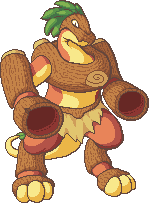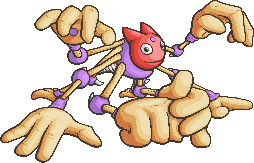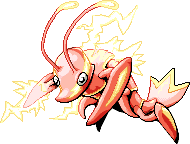OU vs. CAP Vol. 1: Play Styles
| « Previous Article | Home | Next Article » |
Introduction
When most players hear about CAP, they will either scoff or laugh at the thought and with good reason—each time a CAP project happens, we make a top-tier Pokémon for OU. We give it the perfect stats, typing, and movepool so that it can be the best it can be. The net result of all of our previous CAPs, when combined together into one metagame, is oftentimes likened to catastrophe and chaos. This is usually what turns new players off from actually playing the CAP Metagame, which is a tragic loss. This article focuses in illuminating some of the key differences between OU and CAP so that more players can feel at ease with trying CAP out once it's not so terrifyingly different.
Styles of Play
After the banning of Salamence, both the OU and CAP metagames are evolving and trying to balance around the loss of such a powerful and versatile Pokémon. In OU, Salamence was most often seen as a powerful mixed attacker or a potent Dragon Dance sweeper. In CAP, however, Salamence was more commonly used as a defensive pivot against two of the most powerful sweepers ever to hit the streets: Dragon Dance Pyroak and Life Orb Colossoil. Salamence provided an immunity to Ground-type attacks, Intimidate, and key resistances to Grass-, Fire-, and Water-type attacks.
With the loss of Salamence and revisions in the CAP metagame having just finished, the CAP metagame will be evolving a lot from what even the regulars are used to. Playstyles are completely different than what one might expect to see in an OU-based metagame. Stall, offense, and balanced all have new toys and all have new needs based on the inclusion of ten top-tier Pokémon.
Offense

Offensive teams are marked by attacking from the get-go and maintaining offensive pressure throughout a match in order to secure victory by overwhelming the opponent. Wallbreakers are employed to great success to get by common stall, and sweepers are used to drop as many of the opponent's Pokémon as possible in one fell swoop. Heavy offense teams marked by simply doing massive damage with hard-to-wall sweepers or setting up an endgame final sweep with a powerful Pokémon are also members of this playstyle.
How has offense changed in the shift to CAP? Well, in CAP, offense has dozens of new toys with which it can play. Stratagem is the quintessential special sweeper of the metagame, forcing every team to have a dedicated special wall or else they risk being swept. It is specifically because of Stratagem that Pokémon like Revenankh and Blissey work their way onto teams that aren't stall. Thankfully, Revenankh fills this role perfectly for offense, wherein it can function as an effective bulky sweeper while doubling as the perfect opposing Stratagem response.

CAP has given offensive teams access to Pokémon that are both offensively strong and enormously bulky in the process. Krilowatt functions as an excellent response to many Pokémon as well as a powerful attacker with Magic Guard and a Life Orb equipped. For this reason, most of offense in CAP is very bulky and tends toward the balanced style of play rather than the pure offense. Almost none of the CAPs can be OHKOed by common Pokémon, so offensive teams that take advantage of this fare better than those that sacrifice their natural bulk for more offensive power.
In conclusion, offense has changed from frail and powerful sweepers to bulky and less powerful ones. Outside of Stratagem, which is about the most frail offensive Pokémon in use in CAP, everything is very bulky and hits hard in return. That isn't to say that offense is any less effective, it just now has to compete with the terror that is...
Stall

CAP stall is renowned for being, simply put, a royal pain in the ass. Between Arghonaut stopping all setup sweepers and Revenankh trumping Rotom-A in every sense of the word at spinblocking, stall has never been better equipped to maintain a firm grip over the metagame. Factor in that stall also now has Fidgit over Forretress with his fast Encore and ability to place all entry hazards and you can see just how fierce CAP stall is.
The biggest two changes to stall are as mentioned above, Revenankh overtaking Rotom-A as the premier spinblocker and Fidgit overtaking Forretress as the premier entry hazard user with Rapid Spin. Other things contribute to stall's prevalence and iron clutch over the metagame, though. Because Colossoil exists as the premier Dark- and Ground-type of the metagame, Tyranitar has fallen almost entirely off the usage charts. The biggest thing that Tyranitar brought with it was sandstorm, which hurts defensive Pokémon over time by nullifying their Leftovers. Without sandstorm in play, Pokémon as normally crippled as, say, Cresselia can come back into the metagame and wreak havoc defensively. Again, unlike OU, there are no CAP Pokémon that actively use Choice items simultaneously with Trick outside of Stratagem. This practical removal of Trick from the list of things that stall hates has added even more to its power as a style of play.
There are other such changes with stall in the shift from OU to CAP, mostly in the threats that need to be dealt with. Swords Dance Pyroak is a potent wallbreaker that can punch through even the famed setup-stopper, Arghonaut, with his powerful Grass-type STAB attacks. This is perhaps the most ironic thing anyone could ever say, but it is for this reason that stall has actually suffered from the loss of Salamence. Bulky Wish Salamence with Roar was the only true counter that existed for a boosted Pyroak. Without Salamence to stop Pyroak, stall will have to evolve yet again. Furthermore, there exists another major threat to stall in the CAP metagame in the form of a perfect stallbreaker. Stallbreaker Kitsunoh is immune to Seismic Toss, paralysis, and poison and will carry both Will-O-Wisp and Taunt to burn and stop healing, respectively. Stallbreaker Kitsunoh's sheer stall-stopping power requires new changes to the playstyle, including the use of physically bulky SubSeed Pyroak. Lastly, there is always the dangerous Colossoil to contend with. Even though Skarmory walls him to kingdom come, Colossoil can use Taunt to keep Skarmory from setting up on him. Having multiple checks to Colossoil is critical, especially now that one of the more popular checks, defensive Salamence, has been removed from the tier.
CAP stall, despite all of the boons the metagame has given it, is still as predictable as ever. Once you see a few Pokémon, you can guess the remaining ones without fail. Stall also has to contend with how difficult Rapid Spinning is in a metagame rife with Revenankh and the powerful stallbreakers that run rampant on every other team. Usually, a stall team crumbles because it simply cannot cope with a specific wallbreaker or a specific threat that it wasn't expecting, but should be managed by all rights. Outside of the gluttons for punishment that stick with stall through thick and thin, most players will instead play...
Balance

Balance is where it's at in CAP. With 9 of the 11 CAP Pokémon being vulnerable to Spikes and Skarmory so easily walling the omnipresent Colossoil, Balance rules the metagame. This is made even better by the fact that Fidgit complements bulky offense so well with his fast Encore and ability to set up any of the entry hazards as necessary. That Fidgit can beat SubPunch Arghonaut, Bulk Up Revenankh, and even threaten Kitsunoh makes him that much better of a choice for balanced teams.
On the attacking side of balanced teams, all of the bulky offensive CAPs are excellent support. SubPunch Arghonaut is both bulky, able to check and beat almost all setup sweepers, and can dish out massive damage and force numerous switches for entry hazard damage to rack up. With so many Pokémon in the CAP metagame vulnerable to Spikes, just a bit of offensive pressure coupled with a few layers can easily secure win after win for a good player. These balanced teams are also distinct because they mesh offensive power with defensive power. A good example of this is running a powerful sweeper in Pyroak alongside the specially defensive behemoth, Blissey. This tactic can let Pyroak set up multiple times over the course of the match and even completely sweep twice if Blissey carries Healing Wish.
Conclusion
CAP and OU are vastly different, and don't let anyone tell you otherwise. Each and every CAP we create isn't just powerful, it's top class. This not only skews how people play, but it also affects how the metagame itself changes to respond to each threat. You can take one look and see that the chasms between each playstyle are widened in CAP, compared to OU. Stall and offense are much more set in stone with the Pokémon they use and how they play, and both are considerably more effective as a result of this. Balance is also easier to differentiate, and also a lot more powerful. Alternating between the two metagames is extremely difficult, as CAP has a lot more defined roles, making it easier to know what your opponent has and how to respond, but each role and playstyle is much more effective as well, making the job of playing around it harder. If you're up to the rock-paper-scissors gameplay and difficulty of dealing with powerful new Pokémon, you should definitely play a bit of CAP after having read this article; I know I will.
| « Previous Article | Home | Next Article » |